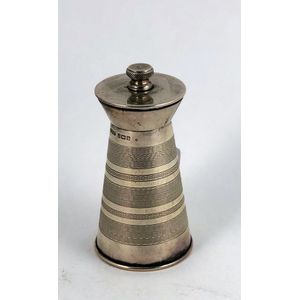Georgian Sterling Silver Cream Jugs, c. 1801
You must be a subscriber, and be logged in to view price and dealer details.
Subscribe Now to view actual auction price for this item
When you subscribe, you have the option of setting the currency in which to display prices to $Au, $US, $NZ or Stg.
- Sterling Silver - Sterling silver is a mixture of 92.5% pure silver and 7.5% of another metal, usually copper. Fine silver is 99.9% pure silver, and is relatively soft and the addition of the very small amount of copper gives the metal enough strength and hardness to be worked into jewellery, decorative and household objects.
- Georgian - As an English stylistic period, Georgian is usually taken to cover the period from George I (1714) to the Regency of Prince George (1811-20), although the period from 1800 to 1830 is sometimes designated as the Regency period. During the Georgian period the great English cabinetmakers and designers such as Chippendale, Hepplewhite, Adam Sheraton etc., were all active.
Therefore there isn't a single 'Georgian style' as such and to say something is 'Georgian', usually means it was made between 1714 and 1830. This assumes we discount George V and George VI, both being from the 20th century.
The styles popular at the time of each reign were:
George I (1714-1727) saw out the last years of the Baroque period.
George II (1727-1760) reigned during the Rococo period.
George III (1760-1820) saw the last gasp of the Rococo, all of the early Neo-Classic 'Adam style' and most of the later neo-Classic 'Regency style'.
George IV (Prince Regent 1820-1830)encompassed the last of the 'Regency' style.
William IV's reign (1830-1837) was something of a no man's land (stylistically) and he wasn't a 'George' anyway. He covered the last glimmerings of 'Regency' and the start of the 'Victorian' style. - Engraving - The method of decorating or creating inscriptions on silver and other metal objects by marking the surface with a sharp instrument such as a diamond point or rotating cutting wheel.
This item has been included into following indexes:
- cream jugs and creamers - silver items 694
- jugs, cream
Visually similar items

Wang Hing Chinese silver milk jug & sugar bowl, with raised dragon decoration and maker's mark to bases, 5.5 cm & 6.8 cm high, 396 grams

A Louis XV early 19th century commode, the rouge marble top of serpentine outline above a pair doors with marquetry foliate decoration, flanked by sides with marquetry panels and ormolu corbels, on high cabriole legs with ormolu sabots. 97 cm high, 112 cm

Queen Elizabeth II sterling silver pepper mill lighthouse shape with engine turned bands, Birmingham, 1968, makers, Joseph Gloster Ltd.

Two sterling silver milk jugs, Georgian and modern Era, 1797 London, an oval jug with two pulvinated borders and a bracket neoclassical style handle, 1969 London, Cj Vander Ltd, a Georgian inspired bright cut bead edged helmet jug with a looping thread dec
